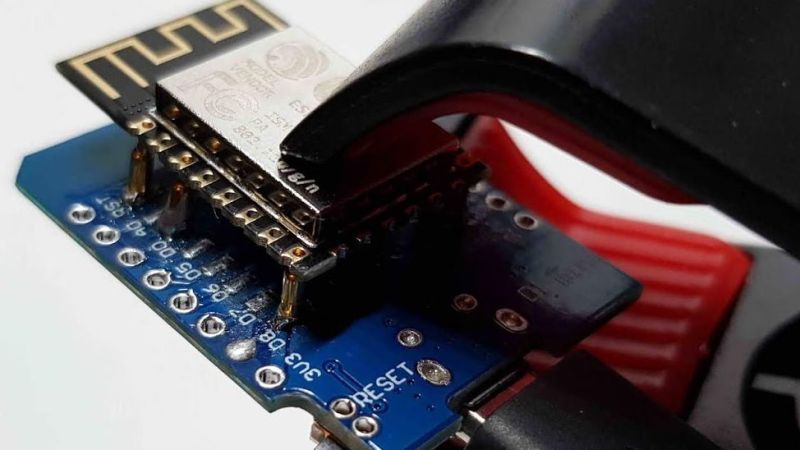Making a programming jig becomes exponentially more difficult after two pins and who would even consider building one if they were not setting up more than twenty boards? If it were easy for novices to construct jigs, we might all have a quiver of them on the shelf next to our microprocessors. Honestly, a tackle box full of homemade programming fixtures sounds pretty chic. The next advantage to ditching the demo boards is that bare processors take up less room and don’t draw power for unnecessary components like unused voltage regulators and LEDs. [Albert David] improves the return-on-time-investment factor by showing us how to repurpose a WeMos board to program a bare ESP8266 module.
[Albert]’s concept can apply to many other surface-mount chips and modules. The first step is to buy a demo board which hosts a programmable part and remove that part. Since you’ve exposed some solder pads in the process, put pogo pins in their place. Pogo pins are small spring-loaded probes that can be surface mounted or through-hole. We’ve used them for programming gorgeous badges and places where the ESP8266 has already been installed. When you are ready to install your software, clamp your Franken-porcupine to the controller and upload like normal. Rinse, wash, repeat. We even get a view of the clamp [Albert] uses.
















Or you could just buy this and save yourself all that time.
https://www.amazon.com/SODIAL-Esp32-Wrover-Fixture-Esp-32-Esp-Wroom-32/dp/B07L3CTVN1/ref=sr_1_103?keywords=esp32&qid=1558212559&s=gateway&sr=8-103
That programmer is for an ESP32. The article above is for an 8266 (eg, ESP12F). The pinouts are completely different. While programmers like the one you link are relatively easy to find, ones for the ESP12 are curiously hard to find.
Yes, it is for the ESP32. you can buy those pins and make one yourself or modify the traces on the ESp32 one.
“””ones for the ESP12 are curiously hard to find.”””
Really? My Amazon page for the above link had an also-interesting reference to:
https://www.amazon.com/Blesiya-ESP8266-Fixture-Minimum-Development/dp/B07MKR2Q7J/
which looks about right, and can handle ESP-01(S), also. I’m not planning to order one, since I have one from Aliexpress, but “esp8266 programming fixture” seems to be the magic search phrase on both Amazon and Aliexpress.
If you need pogo pin connector factory ,they can provide the samples for your test
https://www.pogo-pins.com/
Pogo Pin
I used to work on automated test equipment quite a lot back in the day. Fixtures had hundreds of pins on them. The biggest issue is board alignment, making sure every board fits positively and snugly into the test fixture. The fixtures are also fragile. You want to make sure the board as much as possible can only move up and down, any other motion risks bending pins which may result in springs pinching and the pin filing to make solid contact. For something like programming an 8266, I would just leave a few holes near the edge of the board I could stick but not solder a berg strip into. This works surprisingly good and also lets you program devices without removing the PCB from the case.
It’s actually pretty easy to make custom pogo pin boards. I’d just take the PCB layout for whatever board and resize the through-holes to match the diameter of the pogo pin. Then order at least two of them. When you’re soldering the pogo pins stack the two pcbs with a spacers in between, then solder the pins in. Then you can make whatever jig you want for clamping the testing board down.
Yeah, and if possible have some holes on the board to act as guides.
The ESP8266 craze started in a fun and hackish way, and my hat of to all the wonderfull people who developed frameworks around it to make them easy to use. But still, as long as there is no decent datasheet for the thing I’m not really interested. The 30 page leaflet is a either laughable or sad.
Maybe it would help if Espressiv got flooded with E-mail requests for real datasheets for their IC’s…
(And just maybe it’s already there, I have not checked in the last half year or so)
Also:
Does anybody have any info about the size of the hobby community for these chips compared to commercial products?
I bought 9 of the SonOff switches and 2 LED dimmers built around the ESP8266, with no intention to even use the original firmware embedded in them. Also on sites like Instructables you see tutorials of putting alternative firmware in these things.